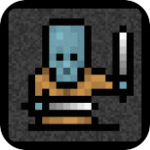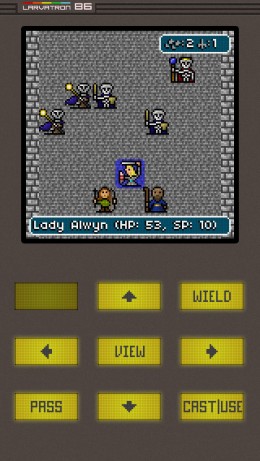 It’s been a tough month for fans of classic CRPGs. Whatever one’s feelings might be on EA’s new Ultima Forever (Free), there’s no questioning the fact that it doesn’t have a lot in common with previous games in the highly (and rightly) revered series. Well, whether your heart was broken, stomped on, and tossed in a dumpster or, you know, not, if you’re looking for something that scratches the itch for some old-school Ultima, you have got to check out Gurk III, the 8-bit RPG ($1.99).
It’s been a tough month for fans of classic CRPGs. Whatever one’s feelings might be on EA’s new Ultima Forever (Free), there’s no questioning the fact that it doesn’t have a lot in common with previous games in the highly (and rightly) revered series. Well, whether your heart was broken, stomped on, and tossed in a dumpster or, you know, not, if you’re looking for something that scratches the itch for some old-school Ultima, you have got to check out Gurk III, the 8-bit RPG ($1.99).
The Gurk series has been around for quite a long time. Yes, it’s not just cashing in on the retro craze with its graphics, they actually looked like that out of former necessity. The first game was originally released on pre-smartphones nearly a decade ago and offered an impressive 15 hour quest in a file size under 64K. The game found new life as an Android release a couple of years back, and sequels followed. Finally, with the third game in the series, iOS fans have a chance to play. In both graphics and user interface, Gurk III is not far removed from its humble Nokia origins, looking very much the part of a Commodore 64-era RPG and playing very much like it was designed for a number pad. Yet, somehow, it is glorious.
 A few months ago, we were treated to 9th Dawn ($2.99), which did a wonderful job of capturing the feeling of the second trilogy of Ultima games. Gurk III isn’t really aiming for that sort of complexity, instead calling to mind the first trilogy of the Ultima series. The simplicity works strongly in its favor, making it well-suited for both brief and longer gameplay sessions. This is not to say the game is lacking in depth or length, as the game is deceptively huge and when the difficulty cranks up, you’ll need to plan your battles like a master strategist. It does, however, streamline some aspects, such as character creation.
A few months ago, we were treated to 9th Dawn ($2.99), which did a wonderful job of capturing the feeling of the second trilogy of Ultima games. Gurk III isn’t really aiming for that sort of complexity, instead calling to mind the first trilogy of the Ultima series. The simplicity works strongly in its favor, making it well-suited for both brief and longer gameplay sessions. This is not to say the game is lacking in depth or length, as the game is deceptively huge and when the difficulty cranks up, you’ll need to plan your battles like a master strategist. It does, however, streamline some aspects, such as character creation.
Your party is always going to consist of three members: a warrior, a ranger, and a mage. For each broad type, you have your choice of three different characters, each with their own unique abilities and stat growth. Once you’ve chosen the character, you can roll and re-roll their starting stats to your heart’s content. After you’ve done this for all three, you’ve officially completed all the input you’ll ever have into your character’s growth. All of the characters turn out to be fairly different, so there’s a lot of incentive to play through the game a couple of more times after you initially finish it. The presence or lack of certain abilities will result in having to totally rewrite your battle strategies, especially in the brutal endgame.
Once underway, you’ll find a pretty familiar style of game if you’ve played any older RPGs or the countless games inspired by them. You venture from town to town on an enormous world map, solving quests issued by the townspeople which usually consist of heading out to some cave, tower, or ruin and defeating the powerful monsters found within. The story of the game is pretty typical for the genre and it’s definitely very light in dialogue, but it does the job well enough. In each town is a shop that sells a continuously changing variety of equipment, an altar that will heal any and all wounds for a price, and not much else. Outside of the towns, battles are triggered both randomly or by touching enemy sprites on the map.
When a battle begins, you’ll enter a seperate rectangular grid-based screen that will look very familiar to old-school Ultima or SSI Goldbox fans. The enemies are lined up at one side, and your characters the other. Any character without a ranged attack needs to be adjacent to whoever they’re attacking, so your ranger will certainly be earning their keep. Once all the enemies are cleared, you’ll be rewarded with some experience points along with some gold and treasure, usually. Should the enemy get the better of you, you’ll be booted back to the last town you visited, with all of your gold stripped away from you. It’s a somewhat insignificant penalty early on in the game, but as you have no way of banking your gold, the cost of failure can be very steep as you progress.
 Your characters start off fairly limited in terms of what they can do in battle, but as you gain levels and gather equipment, you’ll be rewarded with quite an arsenal of techniques. As ever, the mage offers a veritable cornucopia of useful spells, from cures and direct damage to summons and status ailments, but you’ll need to watch your MP carefully. While you’ll regain MP as you walk around, you’ll probably be burning it far faster than you’ll regain it. Bring potions. Lots of potions. Trust me on this one. Gurk III gets difficult pretty early on, eventually reaching a nearly merciless level of challenge. If you don’t plan your battle strategy and resource management well, you’ll be spending a lot of time hiking back from town.
Your characters start off fairly limited in terms of what they can do in battle, but as you gain levels and gather equipment, you’ll be rewarded with quite an arsenal of techniques. As ever, the mage offers a veritable cornucopia of useful spells, from cures and direct damage to summons and status ailments, but you’ll need to watch your MP carefully. While you’ll regain MP as you walk around, you’ll probably be burning it far faster than you’ll regain it. Bring potions. Lots of potions. Trust me on this one. Gurk III gets difficult pretty early on, eventually reaching a nearly merciless level of challenge. If you don’t plan your battle strategy and resource management well, you’ll be spending a lot of time hiking back from town.
While the graphics aren’t much to look at, however charming they might be, the music is a completely different story. Keeping with the style, all of the music is done in chiptune style, and it’s absolutely wonderful. I like to turn the sound off when I’m playing games most of the time, but Gurk III had me popping in my earphones just so I could appreciate each track fully as I made my way through the game. There’s a surprising amount of variety to it, particularly compared to similar efforts on iOS.
While I love this game a lot, it’s not without its negative points. The user interface was clearly designed for a phone with a number pad, and while I like that I can play one-handed, it’s definitely not the smoothest way to go about things, particularly when you have to fish around in the menus. At a basic level, they’re confusingly laid out and inconsistent at times, with the top left button being the info button in some cases but the drop button in others, for example. Additionally, navigating the menus with on-screen arrow keys while we’ve got a perfectly good touch screen sitting here unused is boggling to me. Another thing I’m not too fond of is that Gurk III only allows for one save file. With a variety of characters to choose from, I’d have loved to be able to have two or three files going at one time. Erasing that endgame save with the uber-powerful characters to start a new file definitely requires a gulp and a breath. Finally, if you’re playing on iPad, you’re unfortunately going to have to make do with 2x mode at this time.
Despite those few issues, Gurk III is an excellent game for anyone who enjoys a good RPG. It’s streamlined enough to be non-intimidating to more casual RPG players, but for the more hardcore, still manages to evoke that great feeling of hunching over the keyboard of one’s trusty C64 or Apple II, perilously seeking the end of each dungeon. I sincerely hope we see the older Gurk games and further ones on iOS, because, like many in our forums, I could not put this down until I finished it, and I’m absolutely starved for more.
